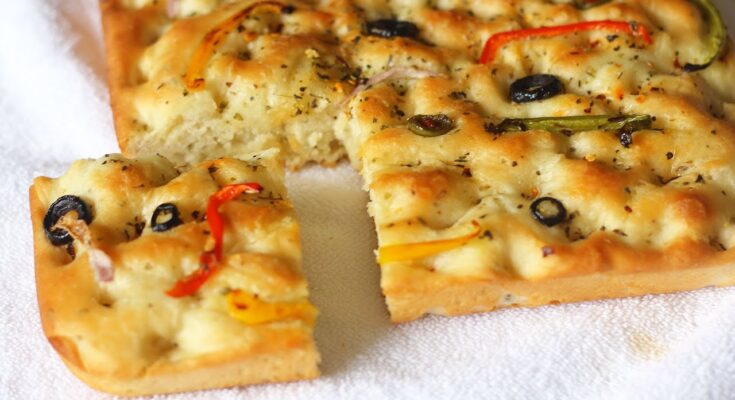Foccacia Recipe: Imagine biting into a piece of focaccia bread—crispy on the outside, fluffy on the inside, with a fragrant drizzle of olive oil and herbs. Sounds divine, doesn’t it? Focaccia is an Italian flatbread that has captured the hearts (and stomachs) of food enthusiasts worldwide. It’s versatile, easy to make, and can elevate any meal. Whether you’re a seasoned baker or a newbie in the kitchen, this guide will help you create the perfect focaccia at home.
What is Focaccia?
Focaccia is a traditional Italian bread known for its chewy texture and olive oil-infused flavor. Originating from ancient Rome, this bread has evolved into a culinary staple, beloved in regions like Liguria, where it’s often flavored with rosemary or salt. Unlike other breads, focaccia’s signature dimpled surface is both aesthetic and practical, as it holds oil and toppings for a burst of flavor in every bite.
Modern variations of focaccia range from savory options like caramelized onions and olives to sweet versions topped with fruits and sugar. No matter how you customize it, focaccia’s charm lies in its simplicity.
Ingredients Needed for Focaccia
Here’s what you’ll need to make classic focaccia:
Basic Ingredients:
- All-purpose flour (3 ½ cups)
- Active dry yeast (2 tsp)
- Warm water (1 ¼ cups)
- Extra virgin olive oil (½ cup)
- Sugar (1 tsp)
- Salt (2 tsp)
Optional Toppings:
- Fresh rosemary
- Sliced cherry tomatoes
- Kalamata olives
- Caramelized onions
- Flaky sea salt
Tips for Ingredients:
- Use high-quality olive oil for the best flavor.
- Fresh herbs and toppings will elevate the taste significantly.
- Warm water should be around 110°F to activate the yeast effectively.
Equipment Needed
To make focaccia, you’ll need:
- Large mixing bowl
- Measuring cups and spoons
- Wooden spoon or spatula
- Baking tray (9×13 inch works best)
- Plastic wrap or a clean kitchen towel
- Oven
Alternative Tools:
- If you don’t have a baking tray, a cast iron skillet works well for smaller portions.
- A stand mixer with a dough hook attachment can save time when kneading.
Step-by-Step Guide to Making Focaccia
Preparing the Dough
- In a large bowl, mix warm water, sugar, and yeast. Let it sit for 5-10 minutes until frothy.
- Gradually add flour, salt, and ¼ cup olive oil to the yeast mixture. Mix until a sticky dough forms.
- Knead the dough on a floured surface for about 10 minutes, or until it’s smooth and elastic.
- Place the dough in a greased bowl, cover it with plastic wrap, and let it rise in a warm place for 1-2 hours, or until it doubles in size.
Preparing the Pan
- Generously grease your baking tray with olive oil. This prevents sticking and adds flavor.
- Once the dough has risen, transfer it to the tray and stretch it gently to fit.
Adding Toppings
- Use your fingers to create dimples across the surface of the dough.
- Drizzle olive oil over the dough and sprinkle with your chosen toppings, like rosemary or tomatoes.
Second Proofing
- Cover the dough loosely with plastic wrap and let it rest for another 30-40 minutes.
- The dough should puff up slightly during this time.
Baking the Focaccia
- Preheat your oven to 450°F (230°C).
- Bake the focaccia for 20-25 minutes, or until the top is golden brown.
- Let it cool for 5-10 minutes before slicing.
Tips for Perfect Focaccia
- Use a generous amount of olive oil for a crisp crust.
- Avoid over-kneading, as it can make the dough too dense.
- If your dough is sticky, lightly flour your hands and work surface.
- Allow the dough ample time to proof for a light, airy texture.
Variations of Focaccia
One of the best things about focaccia is its versatility. You can experiment with different flavors to suit your preferences or the occasion. Here are some popular variations:
Sweet Focaccia Options:
- Honey and Walnut Focaccia: Drizzle honey over the dough and sprinkle with chopped walnuts before baking.
- Cinnamon Sugar Focaccia: Mix cinnamon and sugar, then sprinkle over the dough. Optionally, add raisins for extra sweetness.
- Berry Focaccia: Top with fresh blueberries or raspberries, then dust with powdered sugar after baking.
Unique Savory Topping Combinations:
- Garlic and Herb: Combine minced garlic, thyme, and rosemary for a classic, flavorful topping.
- Potato and Rosemary: Thinly slice potatoes, toss them in olive oil, and layer them on the dough. Sprinkle with sea salt and rosemary.
- Cheese and Jalapeño: Add shredded mozzarella and thinly sliced jalapeños for a spicy kick.
Regional Variations:
- Liguria Focaccia: A classic version topped with olive oil, sea salt, and occasionally fresh herbs.
- Focaccia di Recco: This unique focaccia is filled with soft cheese instead of being topped.
- Tuscan Schiacciata: Often slightly sweeter and sprinkled with sugar or topped with grapes.
Serving Suggestions
Focaccia is as versatile in serving as it is in preparation. Here are some creative ways to enjoy it:
As a Side Dish:
- Serve warm focaccia alongside pasta dishes, soups, or salads. Its rich flavor and texture make it an ideal accompaniment.
For Sandwiches:
- Use focaccia as the bread for your favorite sandwich fillings. Its sturdy texture holds up well with meats, cheeses, and veggies.
Snack Ideas:
- Enjoy focaccia as a mid-day snack by simply dipping it in olive oil and balsamic vinegar.
- Cut it into small squares and top with cream cheese, smoked salmon, or avocado for a fancy appetizer.
Creative Uses:
- Turn stale focaccia into crispy croutons for soups and salads.
- Use it as a base for a quick and easy pizza by adding marinara sauce, cheese, and toppings.
FAQs about Focaccia Recipe
What type of flour is best for making focaccia?
For focaccia, all-purpose flour is typically recommended due to its moderate protein content, which provides the dough with the right balance of chewiness and softness. However, you can also use bread flour for a slightly chewier texture.
How long should focaccia dough rise?
Focaccia dough should generally rise until it doubles in size, which can take anywhere from 1 to 1.5 hours. The dough’s second rise, after shaping and before baking, usually takes about 20 to 30 minutes.
Can I add toppings to my focaccia?
Absolutely! Focaccia is versatile and can be topped with a variety of ingredients such as rosemary, olives, cherry tomatoes, caramelized onions, or coarse sea salt. Add toppings just before the second rise to let them bake into the bread.
Do I need to use olive oil in focaccia?
Olive oil is a key ingredient in focaccia, contributing to its moist, airy texture and distinctive flavor. Generously oil both the dough and the baking pan, and consider drizzling a little extra on top before baking for a crispy, golden crust.
What is the ideal baking temperature for focaccia?
Focaccia should be baked in a preheated oven at 400°F (200°C) for about 20-25 minutes, or until golden brown on top. The high heat helps achieve a crispy crust and fully baked interior.
Can I make focaccia dough in advance?
Yes, focaccia dough can be made in advance. After the first rise, you can refrigerate the dough overnight. Let it come to room temperature and go through the second rise before baking.
How do I know when my focaccia is fully baked?
Focaccia is done when it is golden brown on top and sounds hollow when tapped on the bottom. An instant-read thermometer inserted into the center should read around 190°F (88°C) for perfectly cooked focaccia.
How should I store leftover focaccia?
Leftover focaccia can be stored in an airtight container at room temperature for up to 2 days. For longer storage, wrap it tightly and freeze for up to a month. Reheat in the oven or toaster to restore its crispy texture.
Conclusion
Making focaccia at home is an art that’s simpler than it seems. With just a handful of ingredients, some patience, and a little creativity, you can create a bread that’s bursting with flavor and perfect for any occasion. Whether you’re sticking to the classic recipe or exploring new variations, focaccia is a bread that never disappoints.
So roll up your sleeves, preheat that oven, and enjoy the rewarding process of baking your own homemade focaccia. Trust me, your kitchen will smell like a slice of Italy!



